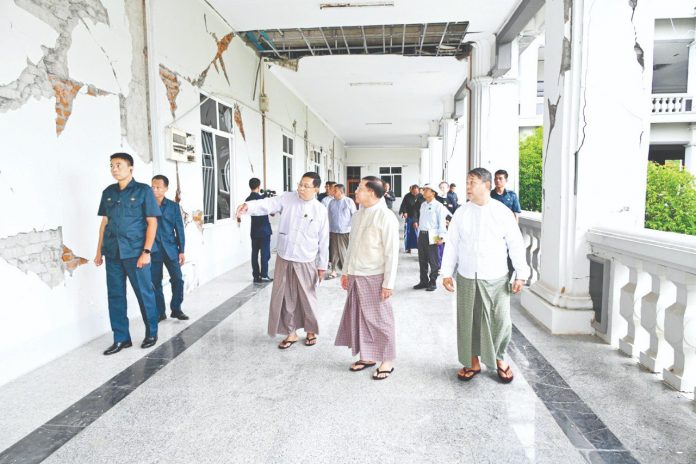At a donation ceremony for earthquake relief held in Naypyidaw on Thursday, regime leader Min Aung Hlaing told the audience that a total of 3,739 have been killed, 5,104 have been injured, and 68 are still missing since March 28.
“Our country Myanmar has been experiencing floods, cyclone occurrences, and droughts almost every year due to climate change disruptions…resulting in significant losses,” said Min Aung Hlaing during his speech on May 29 as reported by regime media.
He added that the quake has impacted 506,069 people and 162,167 households in 10 states and regions, including Sagaing, Mandalay, Magway, Naypyidaw and southern Shan State- the hardest hit during the quake.
At least 4,492 have been killed and 11,366 have been injured by the quake, according to DVB data. The regime’s Department of Meteorology and Hydrology has documented more than 100 aftershocks since March 28.
“We’ve had to stay with relatives since the quake happened because we can’t afford to repair our house yet,” a Mandalay resident told DVB on the condition of anonymity.
The total cost of damage was 3,804,549 billion kyats ($858.77 million USD), according to the regime.
This includes 51,210 residential houses, 11,338 government facilities, 6,730 mobile communication stations, 3,435 electricity poles, 6,469 pagodas and 5,588 other religious buildings in need of repair.
Another 2,409 basic education schools, 72 higher education institutions, 90 private schools, 384 public hospitals, 364 clinics and 650 transportation infrastructure were also damaged. Seventy-eight acres of cropland were destroyed and more than 130,000 livestock died.
The civilian-led National Unity Government (NUG) stated on April 7 that the earthquake severely damaged 32,368 homes, 5,324 religious buildings, 554 schools, as well as 4,603 roads and communication infrastructure.
“We know that they’ve blockaded aid from getting into areas that desperately need it,” Tom Andrews, the U.N. Special Rapporteur on human rights in Myanmar, told DVB.
The NUG called on the international community to ensure aid reaches “those in need, not those in power.” It has raised nearly 1.5 billion kyats ($340,000 USD) for quake relief through its Spring Development Bank (SDB) since March 28.
At the donation ceremony in Naypyidaw on May 29, Min Aun Hlaing told the audience that his regime has received an estimated $32 million USD in donations from domestic and international donors for earthquake relief.
This was the second major fundraising event reported by regime media. The first took place on April 1, when donors contributed approximately $28.28 million USD.
“It’s a very intentional move by this military to obstruct international aid,” Khin Ohmar, the founder of the human rights organization Progressive Voice, told DVB.
Regime media reported that Min Aung Hlaing pledged to give one million kyats ($220 USD) to the family of each person who died in the quake.
“In Pinlaung, families of the deceased were given just 300,000 kyats ($67.72 USD) per deceased person, and those with injured relatives received only 50,000 kyats,” said a resident in Pinlaung Township, which is located 67 miles (107 km) southwest of the Shan State capital Taunggyi.
The U.N. Office for the Coordination of Humanitarian Affairs (UNOCHA) stated on May 17 that many families remain displaced from their homes and have been staying in temporary shelters over the last two months since the quake.
It reported that nearly 509,400 people or 57 percent of the population still urgently needs food aid across the six hardest-hit regions and is calling for additional funding.
The Brotherhood Alliance, comprising the Arakan Army (AA), Myanmar National Democratic Alliance Army (MNDAA), and Ta’ang National Liberation Army (TNLA), declared a one-month ceasefire beginning April 1, which was later extended to May 31.
The NUG declared a unilateral two-week pause in offensive operations, limited strictly to defensive actions in all earthquake-affected areas, starting March 30. This ended on April 22.
The regime ceasefire April 2-30 was renewed May 6-31. DVB data states that the regime has carried out 669 attacks since April 2. It has killed at least 544 people and injured 1,148 others in 809 air and artillery strikes from March 28 to May 28.



